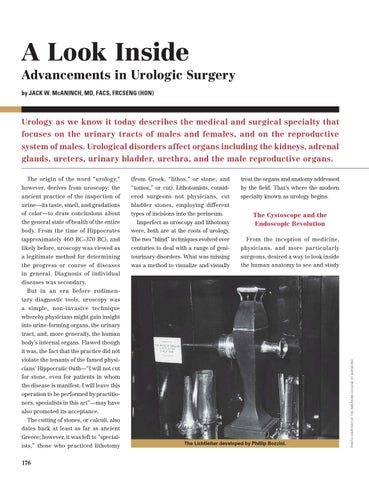A Look Inside Advancements in Urologic Surgery by JACK W. MCANINCH, MD, FACS, FRCSENG (HON)
Urology as we know it today describes the medical and surgical specialty that focuses on the urinary tracts of males and females, and on the reproductive system of males. Urological disorders affect organs including the kidneys, adrenal glands, ureters, urinary bladder, urethra, and the male reproductive organs. The origin of the word “urology,”
(from Greek, “lithos,” or stone, and
treat the organs and anatomy addressed
however, derives from uroscopy: the
“tomos,” or cut). Lithotomists, consid-
by the field. That’s where the modern
ancient practice of the inspection of
ered surgeons not physicians, cut
specialty known as urology begins.
urine—its taste, smell, and gradations
bladder stones, employing different
of color—to draw conclusions about
types of incisions into the perineum.
The Cystoscope and the Endoscopic Revolution
the general state of health of the entire
Imperfect as uroscopy and lithotomy
body. From the time of Hippocrates
were, both are at the roots of urology.
(approximately 460 BC–370 BC), and
The two “blind” techniques evolved over
From the inception of medicine,
likely before, uroscopy was viewed as
centuries to deal with a range of geni-
physicians, and more particularly
a legitimate method for determining
tourinary disorders. What was missing
surgeons, desired a way to look inside
the progress or course of diseases
was a method to visualize and visually
the human anatomy to see and study
in general. Diagnosis of individual diseases was secondary. But in an era before rudimentary diagnostic tools, uroscopy was a simple, non-invasive technique whereby physicians might gain insight into urine-forming organs, the urinary tract, and, more generally, the human body’s internal organs. Flawed though violate the tenants of the famed physicians’ Hippocratic Oath—“I will not cut for stone, even for patients in whom the disease is manifest; I will leave this operation to be performed by practitioners, specialists in this art”—may have also promoted its acceptance. The cutting of stones, or calculi, also dates back at least as far as ancient Greece; however, it was left to “specialists,” those who practiced lithotomy
176
The Lichtleiter developed by Phillip Bozzini.
PHOTO COURTESY OF THE AMERICAN COLLEGE OF SURGEONS
it was, the fact that the practice did not
